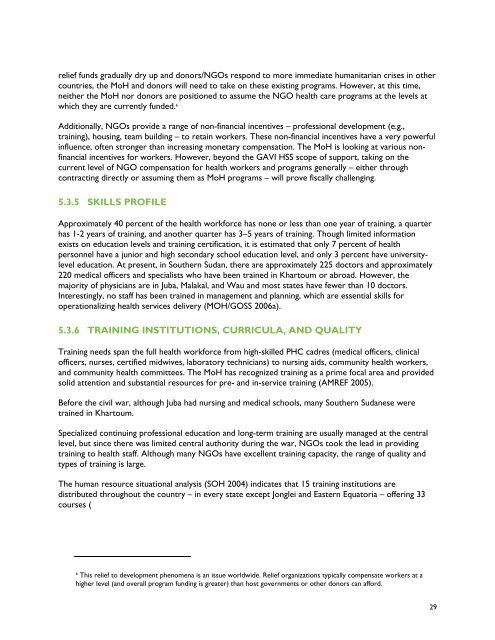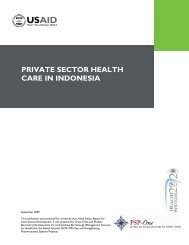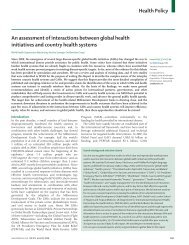southern sudan health system assessment - Health Systems 20/20
southern sudan health system assessment - Health Systems 20/20
southern sudan health system assessment - Health Systems 20/20
Create successful ePaper yourself
Turn your PDF publications into a flip-book with our unique Google optimized e-Paper software.
elief funds gradually dry up and donors/NGOs respond to more immediate humanitarian crises in other<br />
countries, the MoH and donors will need to take on these existing programs. However, at this time,<br />
neither the MoH nor donors are positioned to assume the NGO <strong>health</strong> care programs at the levels at<br />
which they are currently funded. 6<br />
Additionally, NGOs provide a range of non-financial incentives – professional development (e.g.,<br />
training), housing, team building – to retain workers. These non-financial incentives have a very powerful<br />
influence, often stronger than increasing monetary compensation. The MoH is looking at various nonfinancial<br />
incentives for workers. However, beyond the GAVI HSS scope of support, taking on the<br />
current level of NGO compensation for <strong>health</strong> workers and programs generally – either through<br />
contracting directly or assuming them as MoH programs – will prove fiscally challenging.<br />
5.3.5 SKILLS PROFILE<br />
Approximately 40 percent of the <strong>health</strong> workforce has none or less than one year of training, a quarter<br />
has 1-2 years of training, and another quarter has 3–5 years of training. Though limited information<br />
exists on education levels and training certification, it is estimated that only 7 percent of <strong>health</strong><br />
personnel have a junior and high secondary school education level, and only 3 percent have universitylevel<br />
education. At present, in Southern Sudan, there are approximately 225 doctors and approximately<br />
2<strong>20</strong> medical officers and specialists who have been trained in Khartoum or abroad. However, the<br />
majority of physicians are in Juba, Malakal, and Wau and most states have fewer than 10 doctors.<br />
Interestingly, no staff has been trained in management and planning, which are essential skills for<br />
operationalizing <strong>health</strong> services delivery (MOH/GOSS <strong>20</strong>06a).<br />
5.3.6 TRAINING INSTITUTIONS, CURRICULA, AND QUALITY<br />
Training needs span the full <strong>health</strong> workforce from high-skilled PHC cadres (medical officers, clinical<br />
officers, nurses, certified midwives, laboratory technicians) to nursing aids, community <strong>health</strong> workers,<br />
and community <strong>health</strong> committees. The MoH has recognized training as a prime focal area and provided<br />
solid attention and substantial resources for pre- and in-service training (AMREF <strong>20</strong>05).<br />
Before the civil war, although Juba had nursing and medical schools, many Southern Sudanese were<br />
trained in Khartoum.<br />
Specialized continuing professional education and long-term training are usually managed at the central<br />
level, but since there was limited central authority during the war, NGOs took the lead in providing<br />
training to <strong>health</strong> staff. Although many NGOs have excellent training capacity, the range of quality and<br />
types of training is large.<br />
The human resource situational analysis (SOH <strong>20</strong>04) indicates that 15 training institutions are<br />
distributed throughout the country – in every state except Jonglei and Eastern Equatoria – offering 33<br />
courses (<br />
6<br />
This relief to development phenomena is an issue worldwide. Relief organizations typically compensate workers at a<br />
higher level (and overall program funding is greater) than host governments or other donors can afford.<br />
29
















